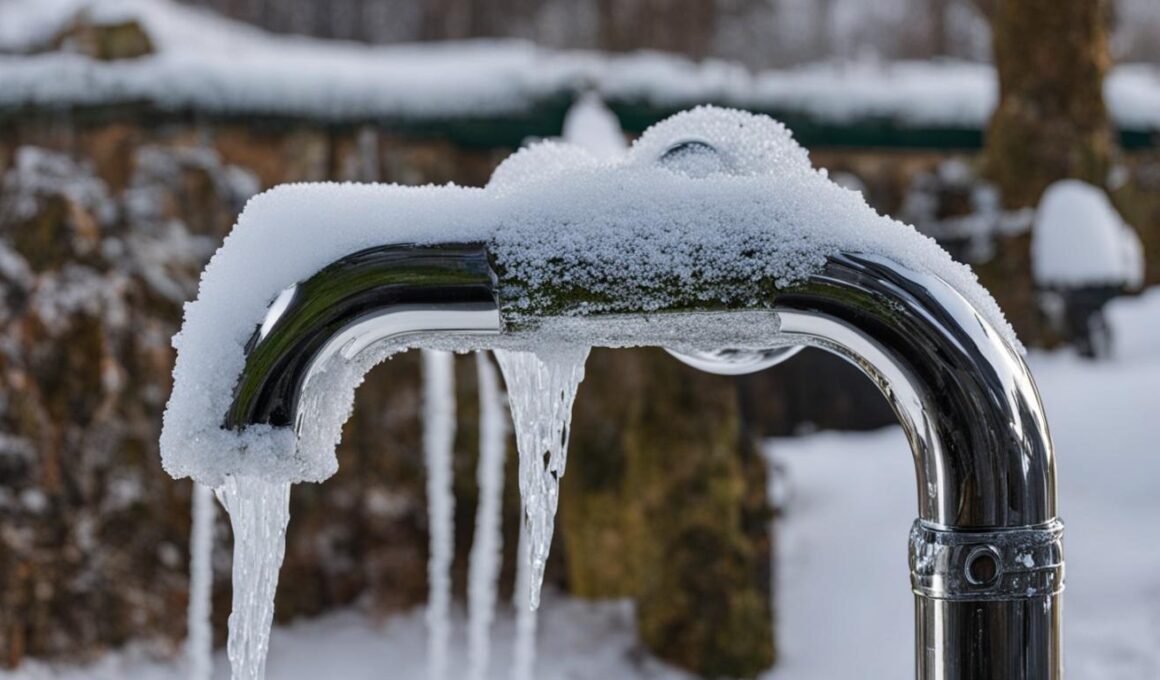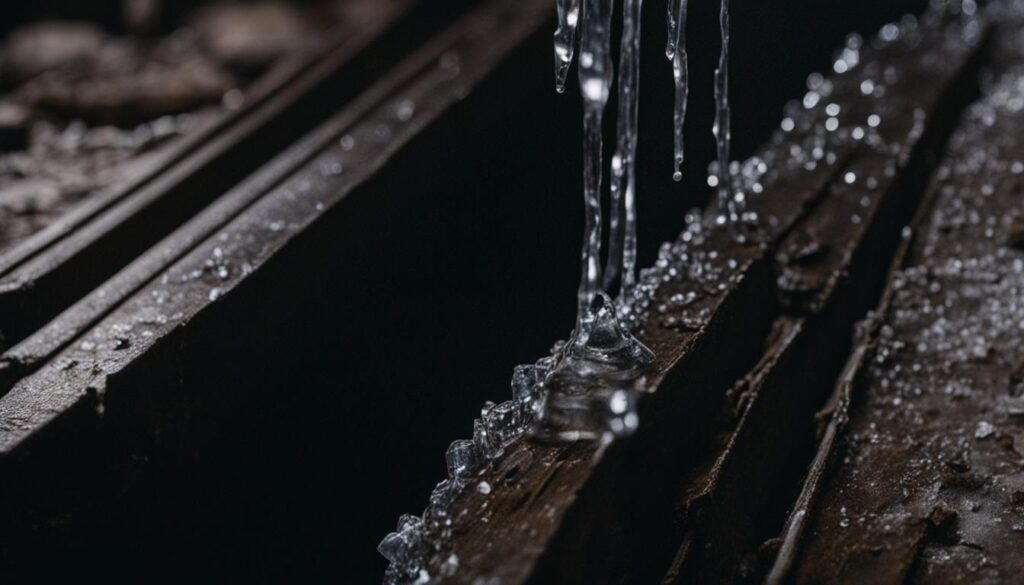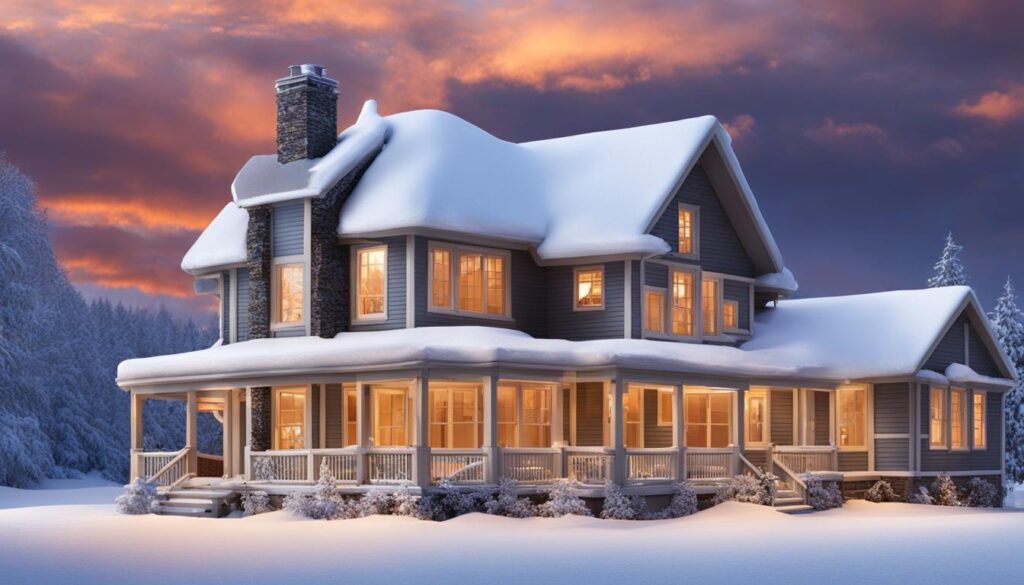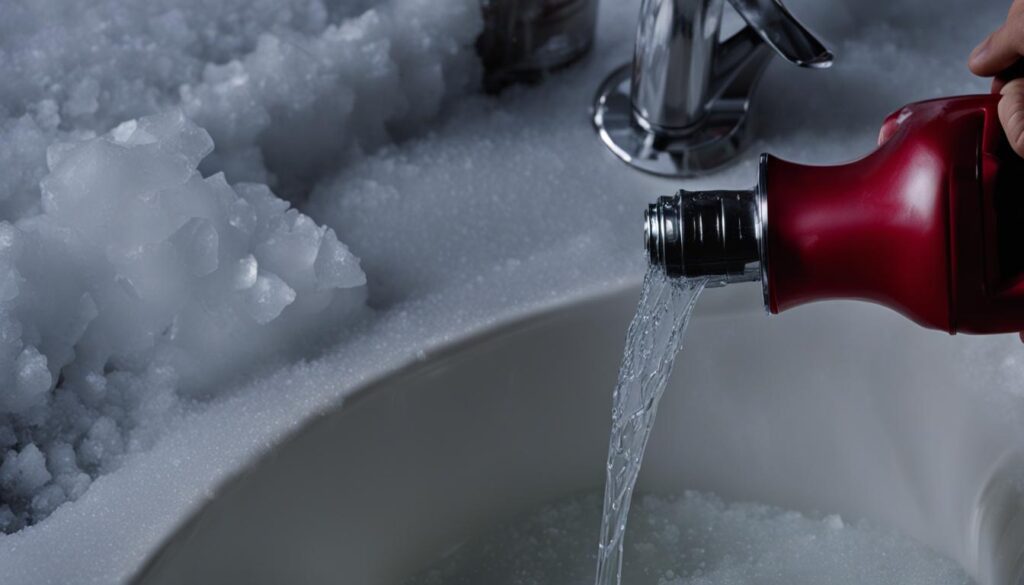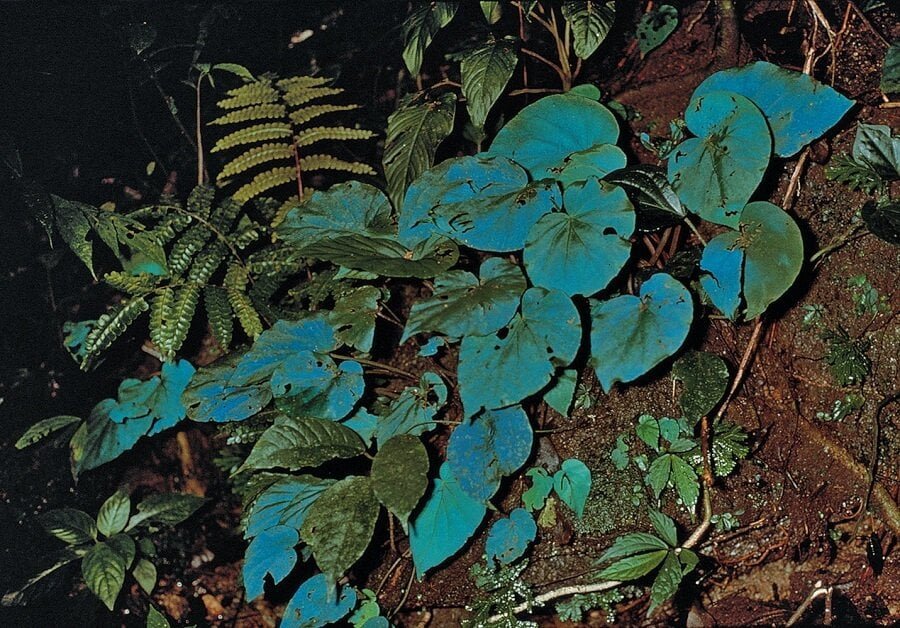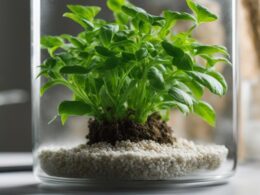Frozen outdoor faucets can be a major headache, leading to burst pipes, water damage, and even flooding. Knowing what steps to take when faced with a frozen outdoor faucet is crucial to prevent further damage and ensure proper functioning of your plumbing system.
Post Summary
- Frozen outdoor faucets can cause burst pipes and water damage.
- Thawing frozen pipes as soon as possible is important to prevent further damage.
- Preventive measures such as disconnecting hoses and insulating pipes can help avoid frozen faucets.
- Thawing a frozen outdoor faucet involves using hot water and insulating towels.
- If you’re unsure or unable to thaw frozen pipes yourself, seek professional assistance to prevent further issues.
When to Worry About Frozen Pipes
Pipes can freeze whenever temperatures drop below 32 degrees Fahrenheit. Extended periods of subzero weather increase the risk of frozen pipes. Pay attention to forecasts and take preventative action when necessary.
Risk of Freezing
Freezing temperatures pose a significant risk to your pipes. When water inside the pipes freezes, it expands and puts pressure on the pipe walls. This pressure can cause pipes to burst, leading to water damage and costly repairs. It’s crucial to be aware of the signs of frozen pipes and take immediate action to prevent further damage.
Signs of Frozen Pipes
- No water coming from faucets
- Unusual smells coming from drains
- Pools of water around the pipes
- Visible frost or ice on the pipes
If you notice any of these signs, there’s a high chance that your pipes are frozen. Take immediate action to thaw them and prevent bursting.
Preventative Action
Prevention is always better than dealing with the aftermath of frozen pipes. When temperatures are expected to drop, follow these steps to protect your pipes:
- Insulate any exposed pipes with pipe insulation or heat tape.
- Keep the thermostat set at a consistent temperature, even when you’re away.
- Open cabinet doors under sinks to allow warm air to reach the pipes.
- Let faucets drip slightly to keep water flowing and prevent freezing.
- Disconnect and drain outdoor hoses.
By taking these preventative measures, you can minimize the risk of frozen pipes and avoid the potential for expensive repairs.
Risk of Frozen Pipes
| Temperature Range (Fahrenheit) | Risk Level |
|---|---|
| 32-25 | Low |
| 24-10 | Moderate |
| Below 10 | High |
Tips to Prevent Frozen Pipes
When winter temperatures drop, it’s crucial to take steps to prevent your outdoor pipes from freezing. Frozen pipes can lead to costly repairs and water damage. By implementing these preventive measures, you can protect your outdoor pipes and ensure they continue to function properly throughout the winter season.
1. Remove and Store Garden Hoses
Before the cold weather sets in, disconnect your garden hoses from the outdoor spigots and store them indoors. When left attached, hoses can trap water and cause the pipes to freeze. By removing and storing the hoses properly, you allow any remaining water to drain out, reducing the risk of freezing and damage.
2. Close the Shut-Off Valve
Locate the shut-off valve for the outdoor faucet and close it tightly. This valve is typically found inside your home, near the area where the outdoor faucet is installed. Closing the valve prevents water from flowing into the outdoor pipes, reducing the chance of freezing. Remember to drain any remaining water from the faucet by opening it briefly.
3. Insulate Exterior Pipes
Protect your outdoor pipes from freezing temperatures by insulating them. Use insulation sleeves or heat tape to wrap the pipes, especially those that are exposed or located in unheated areas. Insulation helps retain heat and prevent the pipes from freezing. Additionally, consider opening cabinet doors under sinks to allow warm air to circulate around the pipes in exterior walls.
| Preventive Steps | Benefits |
|---|---|
| Remove and store garden hoses | Prevents water from trapping and freezing in pipes |
| Close the shut-off valve | Stops water flow to outdoor faucet, reducing risk of freezing |
| Insulate exterior pipes | Helps retain heat and prevent pipes from freezing |
By following these tips to prevent frozen pipes, you can safeguard your outdoor plumbing and avoid the headache and expense of dealing with burst pipes and water damage. With proper preparation, you can enjoy a worry-free winter season knowing that your pipes are protected.
What If Outside Pipes Freeze?
When outdoor pipes freeze, it can lead to significant damage such as burst pipes and water leaks. It’s crucial to take immediate action to thaw frozen pipes and prevent further damage. Follow these steps to thaw your frozen outdoor faucet:
- Turn off the water supply: Locate the shut-off valve for the outdoor faucet and close it to prevent any additional water flow.
- Open the faucet: Keep the faucet open to allow water to flow once it thaws. This will help relieve pressure in the pipe.
- Apply heat: Use a hair dryer, heat gun, or hot towels soaked in hot water to apply heat to the frozen pipe. Start from the faucet and work your way towards the frozen section.
- Monitor the thawing process: Keep a close eye on the faucet to see if water starts to trickle out. This indicates that the pipe is thawing. Continue applying heat until the water pressure returns to normal.
If you’re unable to thaw the frozen pipe yourself or if you encounter any complications, it’s best to seek professional assistance. They can provide expert guidance and ensure that the pipe thaws properly without causing any damage.
Remember, taking prompt action to thaw frozen pipes is essential to prevent burst pipes and water leaks. By following these steps, you can minimize the risk of damage and keep your outdoor faucet functioning properly.
How to Thaw Frozen Hose Bibs
If you find yourself with a frozen hose bib, it’s important to thaw it properly to prevent water damage and ensure proper functioning. Here are the steps to safely thaw a frozen hose bib:
- Open the faucet: Begin by turning on the faucet connected to the frozen hose bib. This will help relieve pressure and allow water to flow once it thaws.
- Wrap with towels: Take towels or rags and wrap them around the frozen section of the hose bib. This will help retain heat and expedite the thawing process.
- Pour hot water: Slowly pour hot water over the wrapped area. The hot water will help melt the ice and thaw the frozen pipe.
- Use a hair dryer: If necessary, you can use a hair dryer on a low setting to provide additional heat. Direct the warm air towards the frozen section of the hose bib.
- Monitor water flow: As the ice begins to melt, you should start to see a trickle of water. Continue applying heat until the water pressure returns to normal.
It’s crucial to keep a close eye on the thawing process to prevent any damage or leaks. If you’re unable to thaw the hose bib yourself or if you notice any issues during the process, it’s recommended to seek professional assistance to avoid further complications.
| Step | Description |
|---|---|
| 1 | Open the faucet connected to the frozen hose bib. |
| 2 | Wrap towels or rags around the frozen section of the hose bib. |
| 3 | Pour hot water over the wrapped area to melt the ice. |
| 4 | Use a hair dryer on a low setting to provide additional heat. |
| 5 | Monitor water flow until the pressure returns to normal. |
Thawing a frozen hose bib requires caution and patience. By following these steps, you can prevent water damage and ensure that your outdoor faucet is in proper working condition.
How to Prevent a Frozen Outdoor Faucet
Preventing a frozen outdoor faucet is crucial to avoid costly damage and ensure the proper functioning of your plumbing system. By taking a few simple precautions, you can protect your outdoor faucets from freezing, even during harsh weather conditions.
Disconnect and Drain Hoses
One of the first steps to prevent a frozen outdoor faucet is to disconnect and drain any hoses connected to it. This is important because leaving a hose attached to the faucet can trap water inside, leading to freezing and potential bursting of the pipes. By disconnecting the hose and allowing any remaining water to drain, you reduce the risk of freezing and subsequent damage.
Close Shut-Off Valves
In addition to disconnecting the hose, closing the shut-off valve for the outdoor faucet is another essential step in preventing freezing. Locate the shut-off valve, usually inside your home, and turn it off to stop the water supply to the outdoor faucet. This will help prevent any remaining water from reaching the faucet and freezing during cold temperatures.
Insulate Tubing or Use Faucet Covers
Insulating the tubing of your outdoor faucet is an effective way to provide additional protection against freezing. You can wrap the tubing with insulating material or use specialized faucet covers. These covers are designed to fit over the faucet, creating an insulating barrier between the cold air and the pipe. By insulating the tubing or using faucet covers, you help maintain the temperature of the water inside the pipe, preventing it from freezing.
| Preventive Measures | Benefits |
|---|---|
| Disconnect and drain hoses | Reduces the risk of frozen pipes |
| Close shut-off valves | Prevents water from reaching the faucet |
| Insulate tubing or use faucet covers | Maintains the temperature of the water |
By following these preventive measures and staying updated on weather forecasts, you can effectively prevent your outdoor faucet from freezing. Taking these simple steps will ensure the proper functioning of your plumbing system and protect your home from potential water damage.
Remember, if you’re unsure or unable to take these preventive measures yourself, it’s always a good idea to seek professional assistance. They can provide expert advice and guidance to protect your outdoor faucets from freezing and minimize the risk of damage.
How to Thaw a Frozen Outdoor Faucet
If you find yourself with a frozen outdoor faucet, it’s important to take action quickly to minimize potential damage. Thawing the faucet properly can help prevent burst pipes and costly water leaks. Here are the steps you can follow to safely thaw a frozen outdoor faucet:
- Cover the faucet: Start by covering the frozen faucet with towels or rags. This will help insulate the area and prevent further freezing.
- Apply hot water: Pour hot water over the covered faucet, focusing on the area where the freezing is occurring. The hot water will help melt the ice and restore water flow.
- Repeat if necessary: If the faucet remains frozen after the first attempt, repeat the process of covering and applying hot water until the ice is completely melted.
- Check water flow: Once the ice has thawed, turn on the faucet to check the water flow. Let the water run for several minutes to ensure proper thawing.
- Ensure proper drainage: To minimize the risk of refreezing, briefly turn off the faucet and then turn it on again to fully drain the water from the pipes.
Thawing a frozen outdoor faucet can be a relatively simple process if done correctly. However, if you’re unsure or uncomfortable with performing these steps yourself, it’s always best to seek the assistance of a professional plumber. They have the expertise and tools necessary to safely thaw the faucet and minimize any potential damage.
Remember, prompt action is crucial when dealing with frozen outdoor faucets. By following these steps and taking the necessary precautions, you can prevent further damage and ensure the proper functioning of your outdoor plumbing system.
Why Do I Need to Disconnect My Hose?
Disconnecting your hose from the outdoor faucet is an important step to prevent frozen pipes and potential bursting. When the hose is left connected during freezing temperatures, water can become trapped inside the pipe, leading to expansion and increased pressure. This can result in cracked or burst pipes, causing costly damage to your home.
By disconnecting the hose, you allow water to drain from the faucet, reducing the risk of freezing and damage. It’s a simple precaution that can save you from dealing with water leaks, flooding, and the need for costly repairs. Remember, prevention is key when it comes to protecting your outdoor faucet and maintaining the proper functioning of your plumbing system.
“Disconnecting the hose during freezing temperatures is a crucial step to prevent frozen pipes and avoid potential bursting.”
The Importance of Preventing Frozen Pipes
Preventing frozen pipes is essential to avoid the inconvenience and expense of dealing with burst pipes. When outdoor faucets freeze, the water inside expands, putting pressure on the pipe walls. This pressure can cause the pipe to crack or burst, resulting in water leaks and significant water damage. Additionally, frozen pipes can disrupt the flow of water to your home, leaving you without running water until the issue is resolved.
To prevent frozen pipes and protect your outdoor faucet, remember to disconnect your hose before freezing temperatures arrive. Taking this simple step can help you avoid the hassle and expense of dealing with a burst pipe and the subsequent water damage it can cause.
| Benefits of Disconnecting Your Hose | Risks of Not Disconnecting Your Hose |
|---|---|
|
|
Tips on How to Prevent a Frozen Outdoor Faucet
Preventing a frozen outdoor faucet is essential to protect your home from burst pipes and water damage. By following these tips, you can ensure that your outdoor faucet remains in proper working condition during freezing temperatures.
Shut Off the Valve and Drain Water
The first step in preventing a frozen outdoor faucet is to shut off the valve that supplies water to the faucet. Locate the shut-off valve, typically found inside your home, and turn it off. Once the valve is closed, open the faucet outside to drain any remaining water.
Disconnect and Store the Hose
Disconnecting and storing your hose during the winter months is crucial for preventing frozen faucets. Water left in the hose can freeze and cause damage to the faucet and pipes. Drain the hose completely and store it in a sheltered area, such as a garage or shed, to keep it protected from freezing temperatures.
Insulate and Protect the Faucet
To provide additional insulation to your outdoor faucet, use Styrofoam protectors specifically designed for this purpose. These protectors help prevent freezing by keeping the faucet and surrounding pipes insulated from the cold. Simply wrap the protector around the faucet, ensuring a snug fit.
Monitor the Weather Forecast
Stay updated on the weather forecast and take precautions when freezing temperatures are expected. If a cold snap is on its way, be proactive in implementing the above steps to prevent a frozen outdoor faucet. By being prepared and taking preventive measures, you can avoid the hassle and expense of dealing with frozen pipes and water damage.
| Preventive Steps | Benefits |
|---|---|
| Shut off the valve and drain water | Prevents water from freezing in the faucet and pipes |
| Disconnect and store the hose | Prevents water from freezing in the hose and damaging the faucet |
| Insulate and protect the faucet | Provides additional insulation, reducing the risk of freezing |
| Monitor the weather forecast | Allows you to take preventive action before freezing temperatures arrive |
By following these tips, you can ensure that your outdoor faucet remains free from freezing and functions properly throughout the winter season. Taking preventive measures will not only save you from the inconvenience of dealing with frozen pipes but also help protect your home from potential water damage.
What’s a Frost-Free Hose Bib?
A frost-free hose bib is a type of outdoor faucet that is designed to prevent freezing and potential bursting during cold weather. It features a built-in valve located inside your home that drains water from the pipe when closed, ensuring that no water is left to freeze and cause damage. This design is especially useful in regions with harsh winters or when extended periods of subzero temperatures are expected.
The frost-free hose bib takes advantage of the principle that water drains downward due to gravity. When the valve is closed, any water remaining in the pipe will flow towards the drain, leaving the pipe empty and protected from freezing. This eliminates the need to manually drain the outdoor faucet or shut off the water supply to prevent freezing.
To install a frost-free hose bib, a section of the pipe is extended further into your home so that the faucet handle is located outside while the valve and pipe are inside the warmed space. This allows the valve to remain insulated and protected from freezing temperatures. It’s important to note that the frost-free hose bib should still be properly insulated to provide additional protection against freezing and bursting.
In summary, a frost-free hose bib is a practical solution for preventing freezing and potential bursting of outdoor faucets. By incorporating a valve inside your home that drains the pipe when closed, it ensures that water is safely removed from the faucet and eliminates the risk of damage caused by freezing temperatures. Upgrade to a frost-free hose bib to provide added protection and peace of mind during the winter months.
How to Thaw a Frozen Outdoor Faucet
If you find that your outdoor faucet has frozen, it’s important to thaw it as soon as possible to prevent bursting and further damage. Thawing a frozen faucet is a relatively simple process that you can do yourself. Here are the steps to follow:
- Start by covering the frozen faucet with towels or rags. This will help insulate the area and prevent heat loss.
- Next, pour hot water over the wrapped area. The hot water will gradually thaw the ice and restore water flow.
- Repeat the process as necessary until the faucet is completely thawed. Be patient and avoid using excessive force to prevent damage to the faucet.
- Once the water is flowing again, it’s important to take further precautions to prevent future freezing. Turn off the water supply to the outdoor faucet from inside your home. This will drain the water in the pipe and reduce the risk of freezing.
Thawing a frozen outdoor faucet is a straightforward task that can prevent costly damage. By following these steps, you can safely thaw your faucet and ensure its proper functioning. Remember to always use hot water and take preventative measures to avoid future freezing.
| Step | Instructions |
|---|---|
| 1 | Cover the frozen faucet with towels or rags to insulate it. |
| 2 | Pour hot water over the wrapped area to thaw the ice. |
| 3 | Repeat the process until the faucet is completely thawed. |
| 4 | Turn off the water supply from inside your home to drain the pipe. |
Thawing a frozen outdoor faucet is an essential maintenance task for homeowners. By following these steps and taking preventative measures, you can prevent bursting and ensure the proper functioning of your faucet.
Conclusion
Taking proactive measures to prevent frozen outdoor faucets is essential in safeguarding your home from potential damage. By following the guidelines outlined in this article, you can significantly minimize the risk of burst pipes, water leaks, and costly repairs.
If you find yourself dealing with frozen pipes and are unsure or unable to thaw them yourself, it is advisable to seek professional assistance. A licensed plumber or experienced technician can safely thaw frozen pipes, ensuring proper thawing and minimizing the risk of further problems.
Remember, prevention is key when it comes to frozen outdoor faucets. By disconnecting hoses, closing shut-off valves, insulating pipes, and monitoring weather forecasts, you can protect your home and avoid the inconvenience and expense of dealing with frozen pipes.
Can I Still Thaw a Frozen Outdoor Faucet If I Didn’t Winterize It Properly?
Yes, you can still thaw a frozen outdoor faucet if you didn’t properly winterize it. Use a hairdryer, heat lamp, or hot towels to carefully warm the pipe. For next time, follow the proper steps on how to winterize outdoor faucet to prevent freezing and damage.
FAQ
What should I do if my outdoor faucet is frozen?
Follow the steps mentioned in the article to thaw the frozen faucet and prevent further damage to your home.
When should I be worried about frozen pipes?
Frozen pipes are a concern when temperatures drop below 32 degrees Fahrenheit, especially during extended periods of subzero weather.
How can I prevent my pipes from freezing?
To prevent pipes from freezing, remove garden hoses from the spigot, close the shut-off valve for the outdoor faucet, and insulate exterior pipes. Opening cabinet doors to allow warm air circulation can also help.
What should I do if my outside pipes freeze?
Thaw the frozen pipes as soon as possible to prevent further damage. Follow the steps mentioned in the article to thaw the frozen outdoor faucet.
How do I thaw a frozen hose bib?
Cover the frozen hose bib with towels or rags and pour hot water over the wrapped area. Repeat as necessary until the faucet is thawed. Confirm water flow and drain the water supply by shutting off the valve from inside your home.
How can I prevent my outdoor faucet from freezing?
Disconnect hoses, close shut-off valves, and wrap spigots with insulating tubing or faucet covers. Stay updated on weather forecasts and take precautions during freezing temperatures.
Why do I need to disconnect my hose?
Leaving a hose connected to the outdoor faucet can lead to frozen pipes and potential bursting. Disconnecting the hose allows water to drain, reducing the risk of freezing and damage.
How can I prevent a frozen outdoor faucet?
Prevent a frozen outdoor faucet by disconnecting the hose, shutting off the valve, and draining the water supply. Insulate tubing or use faucet covers for additional protection.
What is a frost-free hose bib?
A frost-free hose bib has a valve located inside your home that drains water from the pipe when closed. This prevents freezing and potential bursting. Upgrading to a frost-free hose bib provides added protection against frozen faucets.
How do I thaw a frozen outdoor faucet?
Thaw a frozen outdoor faucet by covering it with towels or rags and pouring hot water over the wrapped area. Repeat as necessary until the faucet is thawed. Confirm water flow and shut off the valve from inside your home to drain the water supply.
Why should I seek professional assistance?
If you’re unsure or unable to thaw frozen pipes yourself, seeking professional assistance can help prevent further issues and damage to your home.





